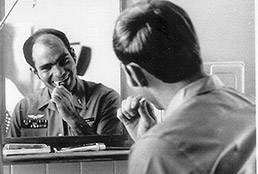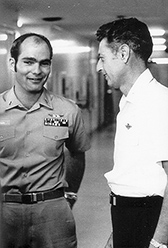Subscriber Benefit
As a subscriber you can listen to articles at work, in the car, or while you work out. Subscribe NowJoe Kernan was suddenly elevated from lieutenant governor to governor upon the death of Gov. Frank O’Bannon in September 2003. Less known about the former South Bend mayor are the harrowing years he experienced in prisoner of war camps in North Vietnam. For his duty, he was awarded the Navy Commendation Medal, two air medals, a combat action ribbon, two Purple Hearts, and Distinguished Flying Cross.
 (Photo courtesy of Joe Kernan)
(Photo courtesy of Joe Kernan)IBJ: I want to hear your war story.
KERNAN: The difference between a war story and a fairy tale is that a fairy tale starts with “Once upon a time.” A war story starts with “No sh–, this really happened!”
IBJ: You served in Vietnam?
KERNAN: I was in the Navy. I wanted to be a pilot, but I knew that I could not because of my poor eyesight. So I settled for becoming a naval flight officer, which is the next best thing.
IBJ: Could you fly the plane if you had to?
 (Photo courtesy of Joe Kernan)
(Photo courtesy of Joe Kernan)KERNAN: At school, naval flight officers were not taught to land an airplane in an emergency. Navy protocol stated that if the pilot was disabled, eject and hope for the best.
IBJ: Did you see combat?
KERNAN: We were based on the aircraft carrier USS Kitty Hawk, in the Gulf of Tonkin in the South China Sea. I was in the reconnaissance unit responsible for taking photographs of the target after the last bombers had dropped their load. We waited at least 30 seconds for the smoke to clear, but no more than 60 seconds because after that the enemy would be crawling out of the foxholes, literally shooting mad. I flew 26 missions.
IBJ: What happened on mission 26?
KERNAN: The target that day was a truck park, a staging area on the main drag of North Vietnam’s Highway 1 at the beginning of the Ho Chi Minh Trail. After taking pictures of the target, my orders were to proceed along the main highway to the Thanh Hoa Bridge in order to gauge the flow of traffic. In many previous runs over seven years, the United States had lost more than 40 aircraft around the bridge—said to be the heaviest-defended turf on the planet, second only to the Kremlin.
IBJ: If the bridge was so highly fortified, why were you sent there?
KERNAN: I have no idea. We just followed orders.
IBJ: OK, what happened next?
KERNAN: I observed the damage from 4,500 feet as our plane flew at 563 knots [just under 650 mph]. Suddenly the plane was hit by anti-aircraft fire—right up the rear end. The nose pitched down. My pilot, Ron Polfer, leveled the wings and turned toward the safety of the water.
Just 10 miles from the beach, less than a minute away, the jet began to plunge to earth. The altimeter was unwinding, but it could not keep up with the dive. I had to bail out. I braced myself and pulled the ejection handle on the seat. I blacked out from the force of the ejection. At the descent speed of the disabled jet—a mile every five seconds—a delay of one more second would have meant certain death.
IBJ: What was your reception?
KERNAN: I woke on the ground just a half-dozen miles from the beach, surrounded by hundreds of women and children. I was stripped to my skivvies and a T-shirt. Three men in uniform appeared and tied a stick behind my back. An argument ensued with the local citizenry about who had custody of the prisoner.
I was pleased that the men in uniform won the altercation. As they ran me toward the river, a child threw a rock that hit me in the back of the head. I remember turning around looking at the young man and thinking, “What a good toss. Could have used him at Notre Dame.”
IBJ: Where were you held prisoner?
KERNAN: I was trucked to Hoa Lo Prison in Hanoi. The prison complex was sarcastically nicknamed the ‘Hanoi Hilton’ by American prisoners of war. I spent four days at the Hanoi Hilton before being transferred to a nearby prison called The Zoo, where I remained for most of my captivity.
IBJ: How long were you a prisoner of war?
KERNAN: For 11 months, and I was served pumpkin soup twice a day virtually every day. It might not shock you, then, that I don’t like pumpkin. Nothing with pumpkin in it or around it—no pumpkin soup, no pumpkin pie, pumpkin seeds, pumpkin anything—nothing.
Click here for other interviews.
Please enable JavaScript to view this content.
